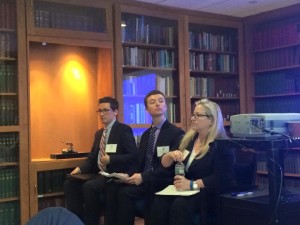A Georgetown Perspective: East Asia’s Relationship with Power
On April 11, Georgetown University students and experts on Asia came together for two different events. During the 2015 Georgetown University China-U.S. Forum, hosted by the Chinese Students and Scholars Association and the 2015 Walsh Exchange, which included a panel entitled

“Peace and Security in Northeast Asia,” students from various universities, experts from national think tanks, and two high-level employees of the World Bank Group shared their research and observations on the state of the region’s relations with the United States as well as recent developments of hard, soft, and most importantly virtual power of Asian countries.
Over the course of the past decade, the terms “hard” and “soft power” have often been used to frame discussions about China’s rise as a major player on the international stage, and they encompass a wide variety of aspects. The umbrella term “hard power” focuses on elements like economic and military might. Indeed, with an economy second in size only to the United States and the largest army in the world, hard power is an effective means for China to assert itself internationally.
At the Walsh Exchange, Boston College student Tate Krasner presented his research on the most novel way that China has sought to assert its hard power: Unmanned Aerial Vehicles (UAV), more commonly known as drones. Drone technology has caused controversy since its use by the United States raised questions about the precision and ethics of drones. But truly taking advantage of drones requires a complex communications and infrastructure network.
Krasner argues that although China’s economic and military rise led to speculation about the nation’s capacity for drone technology, many rumors about the level of development of China’s drones are unfounded; rather, China’s drone capabilities are limited to intelligence rather than military missions. However, according to Krasner, China doubtless has the potential to develop its UAV technology. How much it chooses to use it, however, will also depend on the image it seeks to project.
It is just as important today to balance hard power with an attractive cultural image. Combined with well-regarded political values and conciliatory foreign policies, culture comprises the bulk of soft power. National image was a major topic in the first part of the China-U.S. Forum, during panels entitled “Strengthening China-U.S. Trust” and “The Road to Prosperity.” One major point the panelists discussed was ways for China to improve its image abroad; fighting terrorism and protecting the environment were cited as as two major ways that the Chinese government could take on more responsibilities in the future. However, the panelists also mentioned that in order to get past its image of a government with a history of censorship and human rights abuses, it will be important to promote people-to-people exchanges and cross-cultural understanding.
Newer even than the way countries exploit soft and hard power was the topic of virtual power, which Georgetown University student Jeff Caso grappled with in his presentation. The virtual realm has a unique relationship with both hard power and soft power. Caso looked specifically at China’s cyber-warfare, describing how a part of the People’s Liberation Army (PLA) hacked into various Western and Asian targets. Caso hypothesizes that the PLA’s end goal was to develop its industrial power, showing virtual power’s relationship to hard power.
However, Caso also argued that if virtual power leads to destruction of property or loss of life, it could be equated to hard power. In addition, when China faced international criticism and the Obama administration indicted PLA officers for cyber-espionage, its global image was hurt, showing that virtual warfare has as much of a negative impact on a country’s image as physical warfare can have. Thus, virtual power is clearly a whole new realm that will certainly be studied further in the future.
Although China mostly dominated the conversation throughout the day, Georgetown student Allison Kim’s presentation shifted in focus to South Korea and its wartime operational control, of which the U.S. currently has control, meaning that if South Korea went to war, American officials would command U.S. and Korean forces in battle. Although both countries had been planning to transfer operational control back to South Korea, both nations chose last year to delay the transfer indefinitely. Kim presumes the transfer will occur around 2020, but only on the condition that South Korea develops its early warning capabilities to detect possible attacks as soon as possible. The transfer is crucial, however, to ensure that South Korea reduces its dependency on the United States.
These panelists and students were able to touch on a wide variety of contemporary issues the Asian region is facing, and contributed to Georgetown’s understanding of Asian hard, soft, and virtual power. As China promotes economic initiatives like the Asian Infrastructure Investment Bank and develops its soft power by promoting cultural exchanges with countries all over the globe, the region will develop over the course of the coming years. Even as soon as next year, these same Georgetown events will certainly report even newer issues surrounding the region.
